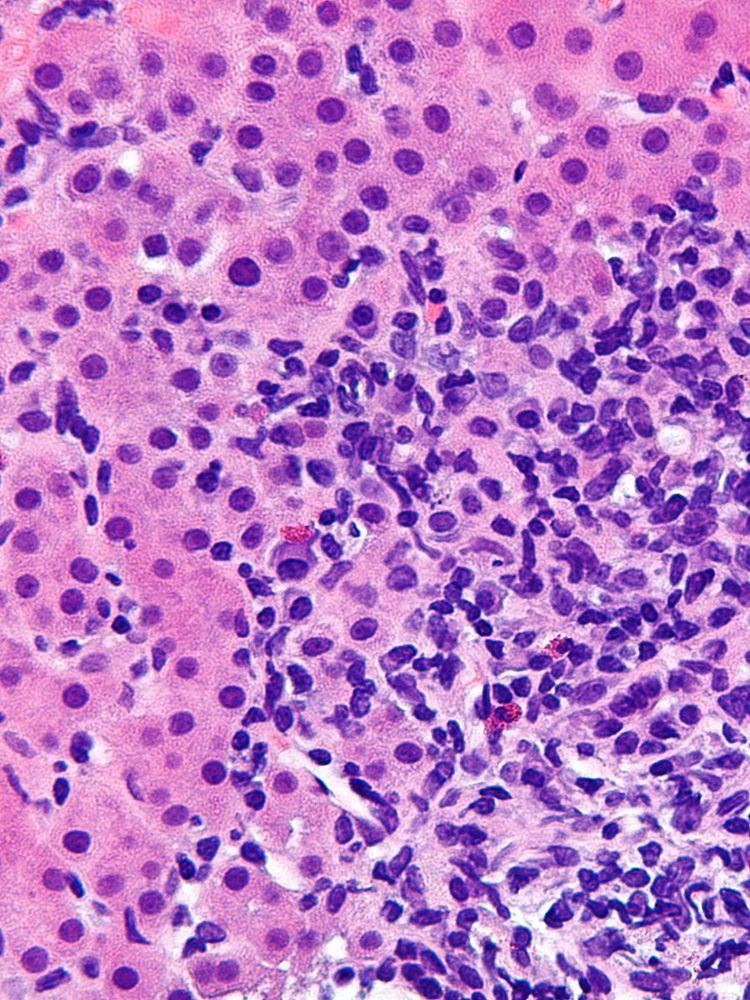ICD-10 K75.4 DiseasesDB 1150 eMedicine med/366 | ICD-9-CM 571.42 MedlinePlus 000245 | |
 | ||
Specialty gastroenterology, hepatology | ||
Autoimmune hepatitis, formerly called lupoid hepatitis, is a chronic, autoimmune disease of the liver that occurs when the body's immune system attacks liver cells causing the liver to be inflamed. Common initial symptoms include fatigue or muscle aches or signs of acute liver inflammation including fever, jaundice, and right upper quadrant abdominal pain. Individuals with autoimmune hepatitis often have no initial symptoms and the disease is detected by abnormal liver function tests.
Contents
Anomalous presentation of human leukocyte antigen (HLA) class II on the surface of liver cells, possibly due to genetic predisposition or acute liver infection, causes a cell-mediated immune response against the body's own liver, resulting in autoimmune hepatitis. This abnormal immune response results in inflammation of the liver, which can lead to further symptoms and complications such as fatigue and cirrhosis. The disease may occur in any ethnic group and at any age, but is most often diagnosed in patients between age 40 and 50.
Signs and symptoms
Autoimmune hepatitis may present completely asymptomatic (12–35% of the cases), with signs of chronic liver disease, or acute or even fulminant hepatic failure.
People usually present with one or more nonspecific symptoms, sometimes of long lasting duration, as fatigue, general ill health, lethargy, weight loss, mild right upper quadrant pain, malaise, anorexia, nausea, jaundice or arthralgia affecting the small joints. Rarely, rash or unexplained fever may appear. In women, amenorrhoea is a frequent feature. Physical examination may be normal, but it may also reveal signs and symptoms of chronic liver disease. Many people have only laboratory abnormalities as their initial presentation, as unexplained increase in transaminases and are diagnosed during an evaluation for other reasons. Others have already developed cirrhosis at diagnosis.
Autoimmune hepatitis frequently appears associated with other autoimmune conditions, mainly celiac disease, vasculitis, and autoimmune thyroiditis.
Cause
60% of patients have chronic hepatitis that may mimic viral hepatitis, but without serologic evidence of a viral infection. The disease usually affects women and is strongly associated with anti-smooth muscle autoantibodies.
Diagnosis
The diagnosis of autoimmune hepatitis is best achieved with a combination of clinical, laboratory and histological findings after excluding other etiological factors (e.g. viral, hereditary, metabolic, cholestatic, and drug-induced diseases).
A number of specific antibodies found in the blood (antinuclear antibody (ANA), anti-smooth muscle antibody (SMA), liver/kidney microsomal antibody (LKM-1, LKM-2, LKM-3), anti soluble liver antigen and liver–pancreas antigen (SLA/LP) and anti-mitochondrial antibody (AMA)) are of use, as is finding an increased Immunoglobulin G level. However, the diagnosis of autoimmune hepatitis always requires a liver biopsy.
Expert opinion has been summarized by the International Autoimmune Hepatitis Group, which has published criteria which utilize clinical and laboratory data that can be used to help determine if a patient has autoimmune hepatitis. A calculator based on those criteria is available online.
Overlapping presentation with primary biliary cirrhosis and primary sclerosing cholangitis has been observed.
Classification
Four subtypes are recognised, but the clinical utility of distinguishing subtypes is limited.
- positive ANA and SMA, elevated immunoglobulin G (classic form, responds well to low dose steroids);
- positive LKM-1 (typically female children and teenagers; disease can be severe), LKM-2 or LKM-3;
- positive antibodies against soluble liver antigen (this group behaves like group 1) (anti-SLA, anti-LP)
- no autoantibodies detected (~20%) (of debatable validity/importance)
Treatment
Treatment may involve the prescription of immunosuppressive glucocorticoids such as prednisone, with or without azathioprine, and remission can be achieved in up to 60–80% of cases, although many will eventually experience a relapse. Budesonide has been shown to be more effective in inducing remission than prednisone, and result in fewer adverse effects. Those with autoimmune hepatitis who do not respond to glucocorticoids and azathioprine may be given other immunosuppressives like mycophenolate, ciclosporin, tacrolimus, methotrexate, etc. Liver transplantation may be required if patients do not respond to drug therapy or when patients present with fulminant liver failure.
Prognosis
Autoimmune hepatitis is not a benign disease. Despite a good initial response to immunosuppression, recent studies suggest that the life expectancy of patients with autoimmune hepatitis is lower than that of the general population. Additionally, presentation and response to therapy appears to differ according to race. For instance, African Americans appear to present with a more aggressive disease that is associated with worse outcomes.
Epidemiology
Autoimmune hepatitis has an incidence of 1-2 per 100,000 per year, and a prevalence of 10-20/100,000. As with most other autoimmune diseases, it affects women much more often than men (70%). Liver enzymes are elevated, as may be bilirubin.
History
Autoimmune hepatitis was previously called "lupoid" hepatitis. It was originally described in the early 1950s.
Most patients do have an associated autoimmune disorder such as systemic lupus erythematosus. Thus, its name was previously lupoid hepatitis.
Because the disease has multiple different forms, and is not always associated with systemic lupus erythematosus, lupoid hepatitis is no longer used. The current name at present is autoimmune hepatitis (AIH).
